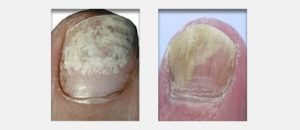What has caused my Fungal Toenail?
A fungal toenail is the result of an infection from a particular classification, or genus, of fungi called Trichophyton, with the more common species affecting the skin of the feet and toenails being Trichopyton rubrum. The fungal spores often reside on our skin but in such small numbers so as to not cause any infections, much like bacteria. However, if the conditions are right, such as a warm, moist environment, the fungi can rapidly grow or ‘culture’. It can potentially survive on our skin, in socks, insoles of shoes and carpets.
Reasons for a Fungal Toenail Infection
In a fungal toenail infection, the fungal spores get underneath the toenail and culture within the cells of the nail bed. This may occur as a result of the nail lifting off the nail bed due to minor injury or incorrect nail cutting. Additionally, if nail polish has been left on for too long the nail polish may begin lifting off the nail plate creating a warm, moist environment for the fungi to grow. This type of fungal infection is known as superficial white onychomycosis and appears as multiple white flakey spots on the nail.
The fungi is know to be keratinophilic which means it consumes the keratin that makes up our nails. This explains why the nail itself becomes discoloured, friable and distorted and thickened.
Treating a Fungal Toenail Infection
Treating your infected fungal toenail can be frustrating as the fungi easily spreads to other cells and the treatment needs to reach the nail bed to target the fungal cells. Many topical antifungal lotions rely on penetrating through the nail to the infected nail bed, however as many fungal nails are thick and distorted this can be a challenge. Other newer treatments use light therapy in conjunction with a special gel that penetrates into the fungal cells and is then activated by the light, such as PACT.

Contact Lefort Podiatry to book an appointment with one of our experienced podiatrists.
BOOK NOW
[formidable id=”3″]
